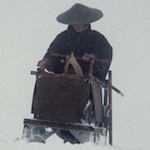 LONE WOLF AND CUB: WHITE HEAVEN IN HELL is the final film in the LONE WOLF AND CUB series – six films released between 1972 and 1974. It has the same writer of the previous one, Tusutomu Nakamura, but a director who’s new to the series, Yoshiyuki Kuroda (THE GREAT YOKAI WAR).
LONE WOLF AND CUB: WHITE HEAVEN IN HELL is the final film in the LONE WOLF AND CUB series – six films released between 1972 and 1974. It has the same writer of the previous one, Tusutomu Nakamura, but a director who’s new to the series, Yoshiyuki Kuroda (THE GREAT YOKAI WAR).
This is a good one to watch in winter because, as poetically described in the title, a bunch of it takes place in the snow. It opens with our deadly assassin papa and child, Ogami Itto (Tomisaburo Wakayama) and Daigoro (Akihiro Tomikawa), skiing their weapon-filled babycart down a mountain. Must be a tall one because time passes, the sky turns dark, Ogami’s carrying a torch. Then the screen turns completely white and you see their silhouettes slowly become visible in the distance, like the opening of FARGO. And come to think of it I’m surprised this babycart doesn’t have a built in woodchipper. It has just about everything else you could need. Maybe it does and we just don’t see him use it.
I don’t think this was planned as the final chapter, but for a while it plays like it’s going to bring everything full circle. In the first one, SWORD OF VENGEANCE, Lord Retsudo Yagyu (Minoru Oki, HORRORS OF MALFORMED MEN) killed Ogami’s wife Azami and framed him as a traitor so as to steal his position as the Shogun’s executioner for the Yagyu ninja clan. In this one Ogami visits Azami’s grave and tells her he’s going to Edo to finally kill Retsudo. While praying over her, Ogami senses something and fires the babycart’s proto machine guns into a wall. Blood drips from the bullet holes, then the walls break and dead Kurokawa ninjas fall out. Why anybody thinks they can sneak up on Ogami Itto in this day and age, I have no idea.
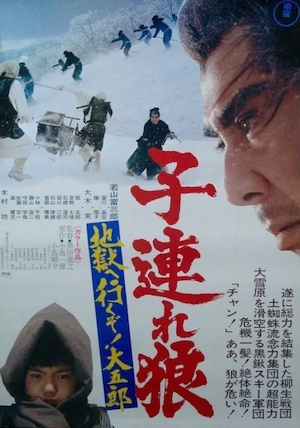 Word has gotten back to the Shogun that Ogami is still alive, traveling around with his little son, fucking shit up and being indisputably, by far the baddest motherfucker who ever lived. So the Shogun sent men after them and contemplates an “open attack,” which is the Tokugawa era equivalent of in JOHN WICK CHAPTER 2 when he’s declared excommunicado and all the other assassins’ pagers go off.
Word has gotten back to the Shogun that Ogami is still alive, traveling around with his little son, fucking shit up and being indisputably, by far the baddest motherfucker who ever lived. So the Shogun sent men after them and contemplates an “open attack,” which is the Tokugawa era equivalent of in JOHN WICK CHAPTER 2 when he’s declared excommunicado and all the other assassins’ pagers go off.
That would be a humiliating failure for Retsudo, so he begs for one more shot. Turns out he has a daughter named Kaori (Junko Hitomi) who he claims is actually better than his sons who died trying to kill Ogami in previous movies. Cut to Kaori in training, her opponent falling dead with her dagger poking out of his skull like the sword in the stone. As impressive as it seems to us, Retsudo still scolds her that she’s too slow.
So she continues practicing her technique of juggling daggers and luring her opponents into their paths. In my opinion, sparring partner to Kaori Yagyu is one of the most thankless jobs, even if Retsudo does a little ritual with their bodies afterwards, asking for their forgiveness. Killing their best men for practice is a going-too-far tactic of Verhoevien proportions, but at the same time, Retsudo acknowledging that it’s sad seems kinda sweet by his standards.
Kaori very briefly survives the mirror trick that killed her brother Kurando in the first movie, but not long enough to argue she’s any better than him. Her undoing is being shocked that Ogami would put Daigoro on his shoulders while she’s doing her dagger juggling. “Aren’t you his father? Coward!” she says while bleeding out.
Of course, you and I both know that he and his son live the Demon Way in Hell together and stand ready to descend to Hell through the Six Realms and Four Lives. Men didn’t really go to therapy in those days, unfortunately.
Having lost his only daughter, Lord Yagyu digs deep into his closet of skeletons and reveals that he has another previously unmentioned kid. Hyoe (Isao Kimura, HIGH AND LOW) was born to a mistress and abandoned at the age of 5, deep in the mountains where he “grew up among birds and beasts.” When Retsudo tracks him down and begs him to save the Tokugawa Shogunate and Ura-Yagyu from becoming a laughing stock by killing Ogami Itto, Hyoe is basically like “fuck you, you’re not my dad” and instead goes to kill him on behalf of his own clan. He identifies as Underground Spider Clan, guys who follow Ogami around beneath the surface of the earth, and we just see the dirt moving like there’s a cartoon mole under there!
The Spider Ninjas use a horrific approach called “Tsuchigumo Five Wheels,” which involves invisibly stalking Ogami and Daigoro and then massacring absolutely anyone they come in contact with – merchants, innkeepers, random passerby. Makes it impossible for them to get directions or a coffee or whatever.
Remember two paragraphs ago I said Retsudo lost his only daughter? Later somebody reminds him that he also fathered Hyoe’s sister Lady Azusa (Chie Kobayashi, SYMPATHY FOR THE UNDERDOG). Man, this guy gets around. Hyoe tries to force Azusa to have his baby as a way of getting back at their father. Not to virtue signal, but I’m against that for a long list of reasons.
I love the music throughout this series. This is the only one composed by Kunihiko Murai (ZATOICHI IN DESPERATION, HANZO THE RAZOR: SWORD OF JUSTICE, TAMPOPO), who delivers the most blaxploitation influenced of the soundtracks – funky wah-wahs, heavy horns, laid back strings. Occasionally it stops to quote Modest Mussorgsky’s “Night on Bald Mountain.” Note that this is three years before it became David Shire’s “Night On Disco Mountain” in SATURDAY NIGHT FEVER and ten years before it was used as the theme for THE TOXIC AVENGER.
The cinematographer is Chikashi Makiura (various ZATOICHI movies, various SLEEPY EYES OF DEATH movies), returning after shooting the first three and then skipping numbers 4 and 5. Maybe the time off was invigorating, because this one looks particularly good, with some very moody atmosphere and haunting imagery.
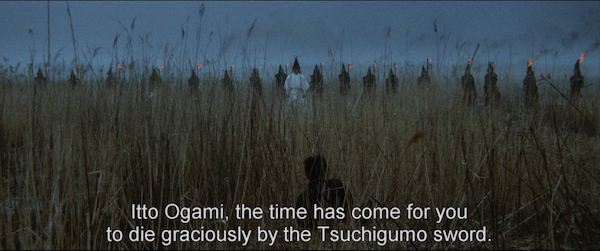
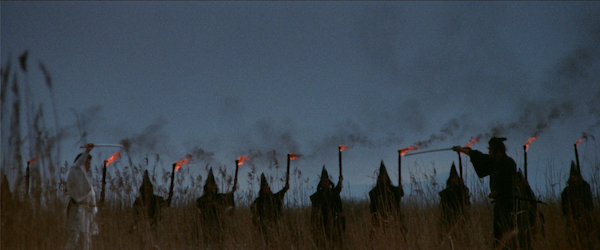

The last 30 minutes take place in the snow. Ogami goes into the mountains and makes a little igloo so the spider ninjas will have to dig around in the snow and freeze their asses off. When he’s got them dead to rights one makes a dying wish for his face to change to show emotion. It seems like it could be the finale, but then they’re babycart-skiing through the snow the next day and Daigoro points at the horizon where Retsudo and dozens, maybe hundreds of soldiers are waiting to kill them. I mean, I’m not a parent so maybe this is pretty normal but I gotta imagine if you have a tiny little kid (especially one in an adorable snow outfit like this) and he points and you look up and it’s that then you’re gonna be like “oh shit,” right? It seems like you would.
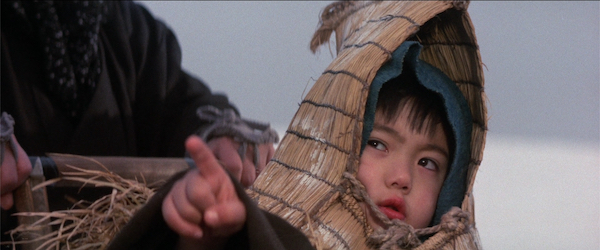
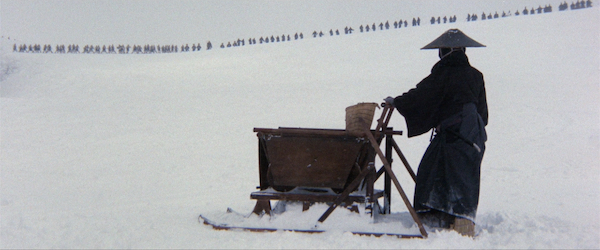
Retsudo makes a speech and kinda sounds like he’s gonna duel, but no, he’s gonna send all kinds of dudes on skis with swords and spears and stuff to slide down there and have their blood beautifully splattered across the snow. One guy sees something like 60 or 70 of his compatriots get slaughtered right in front of him, so he tries to jump over Ogami, who slices him in half mid-air. That’s only the first, much smaller wave of guys that he kills. He has approximately a John Woo movie’s worth of whatever he fires out of those guns, and then he has his blades, and he never gets tired. I’m sure some of these people played dead and rolled down the mountain, but they probly froze to death. According to moviebodycounts.com there are 104 people killed in the finale alone, as compared to a total of 67 throughout RAMBO: FIRST BLOOD PART II. They credit Ogami with 150 kills in the film and Daigoro with 37.
The ending is really funny because Retsudo says, “He may be Lone Wolf and Cub, but I swear to kill him”… as he’s sledding the fuck out of there like he’s late for his wedding!
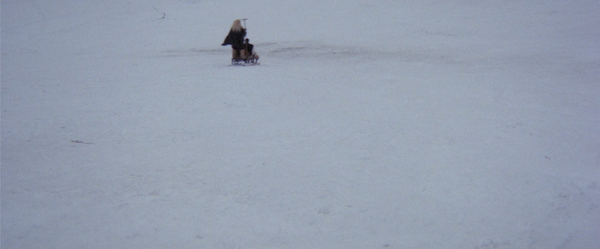
The coward. I bet he knew this was the last movie in the series when he said it, too.
Then there’s an amazing shot from the distance of Ogami surrounded by the last forty or so of the people he killed, and even though he’s tiny on the screen you’re able to see a glint of light reflecting off his blade as he sheaths it. Man, I love these movies.
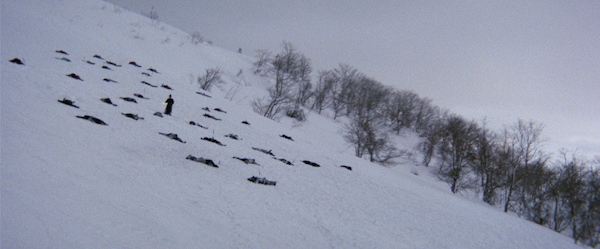
The manga by writer Kazuo Koike and artist Goseki Kojima started in 1970 and ended in 1976, so they probly didn’t know the ending yet when they made this movie. I know I used to act like comics were only for nerds, but I confess that over some time and with quite a bit of effort (because they went out of print) I managed to buy and read all 28 of those little books published by Dark Horse Comics in the early 2000s. In the comics there’s an incredible stretch where Ogami and Retsudo finally come face to face for a duel but they call a temporary truce to go save a village from flooding. They leave their swords in the ground to signal that the duel is on pause and will continue, and Daigoro stays to make sure no one steals the swords. People see him and are so terrified by the sight of a kid left to guard swords that they don’t fuck with him. I did not foresee in the dozens of earlier stories that the evil Lord Yagyu would be shown to have a sense of honor and other positive qualities, or that we’d begin to understand his point of view a little more, and there’s something irresistible about these opposing forces gaining respect (if not admiration) for each other. It builds to a really great and dramatic ending, an excellent example of something that starts as cool little stand-alone short stories but slowly starts to build into a larger narrative. Honestly, one of the best things I’ve ever read.
The movies pale in comparison, but they’re still fucking great. Long live the Demon Path.
* * *
other Japanese films released in 1974: BATTLES WITHOUT HONOR OR HUMANITY: POLICE TACTICS, BATTLES WITHOUT HONOR OR HUMANITY: FINAL EPISODE, DEMON SPIES (written by Kazuo Koike), EVIL OF DRACULA, FLOWER AND SNAKE, GODZILLA VS. MECHAGODZILLA, HANZO THE RAZOR: WHO’S GOT THE GOLD? (also based on a Kazuo Koike manga), KAMEN RIDER X, LADY SNOWBLOOD: LOVE SONG OF VENGEANCE (also also based on a Kazuo Koike manga), NEW BATTLES WITHOUT HONOR OR HUMANITY, RETURN OF THE STREET FIGHTER, SISTER STREET FIGHTER, SISTER STREET FIGHTER: HANGING BY A THREAD, THE STREET FIGHTER. (Wikipedia also lists THE YEAR WITHOUT A SANTA CLAUS because maybe it had some Japanese funding?)

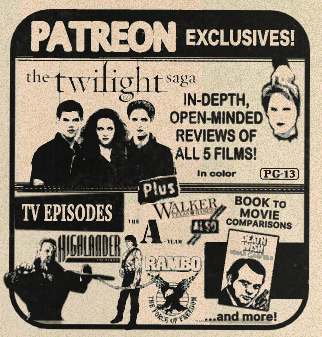

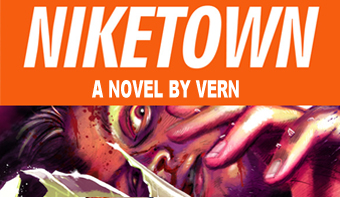
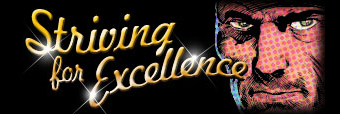
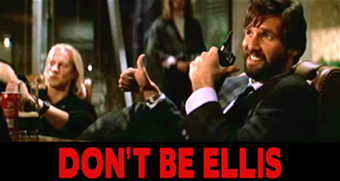

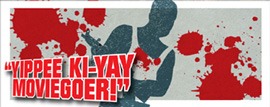








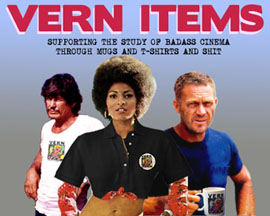
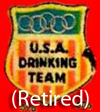
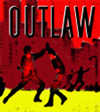






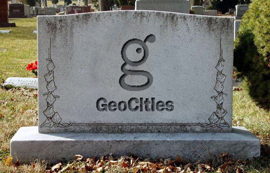
January 10th, 2024 at 9:33 pm
Like, 20-ish years ago I was on a web forum where we’d count the number of people who died in various movies, with breakdowns by character, and this was far and beyond the leader in single-character murder. I think I prefer Baby Cart in the Land of Demons but I will admit to being a sucker for sledding/skiing setpieces so it’s close.